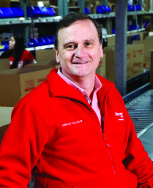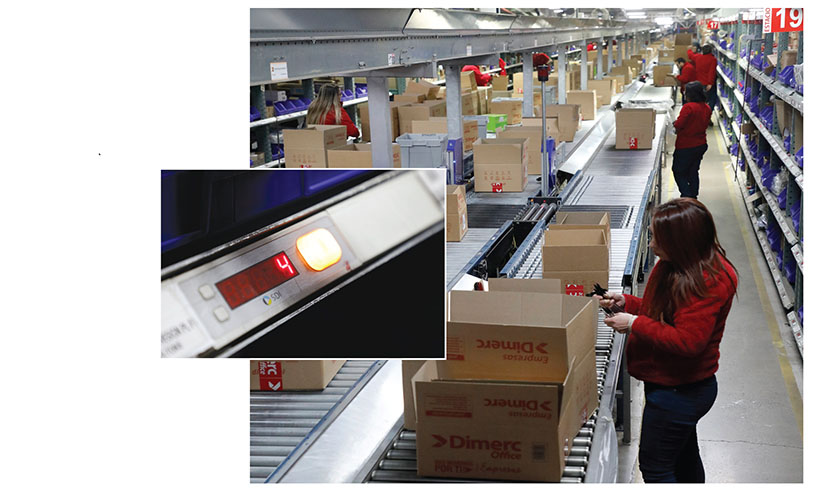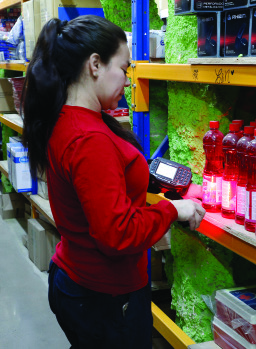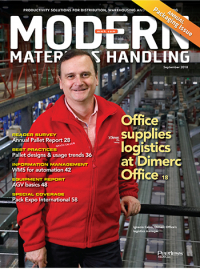Office supplies logistics at Dimerc Office
Chile’s largest B2B distributor of office supplies added a three-level pick module and a high-speed shipping sorter to its distribution center. The result was a 30% increase in productivity.
In 2016, Empresas Dimerc, the parent company of Dimerc Office, Chile’s largest distributor of office supplies to business, automated the picking processes in its 216,000-square-foot distribution center in Santiago.
 Among its goals: To become the most modern distributor of office supplies in its home country, but to also rival the best of its peers worldwide. “We are continuously evaluating process improvements and looking at possibilities for automation,” notes Ignacio Calvo, Dimerc Office’s logistics manager.
Among its goals: To become the most modern distributor of office supplies in its home country, but to also rival the best of its peers worldwide. “We are continuously evaluating process improvements and looking at possibilities for automation,” notes Ignacio Calvo, Dimerc Office’s logistics manager.
The project came at a time when Dimerc was seeing significant growth in its business as it strove to provide national distribution to every big company in Chile and planned to add third-party drop-ship and fulfillment services. The company has no stores, so the orders picked to serve some 4,000 customers every day are delivered directly to office buildings. “We needed to increase our production capacity, control our labor resources, improve quality and decrease errors along with decreasing the number of credit notes we issued for missing items, damaged goods and other mistakes,” Calvo says. Accuracy was also important in reducing the number of returns that had to be dealt with.
The solution: Working with a Santiago-based systems integrator (SDI Systems), Dimerc expanded an existing conveyor system; installed a three-level pick module for item picking using pick-to-light and RF scanning to enable pick-and-pass picking based on the velocity of movement of SKUs; implemented RF-directed carton picking in place of paper-based picking; added an array of scanners for quality control as well as a quality control area; and installed a high-speed shipping sorter that can handle 6,000 cartons per hour and service 21 dock doors.
The result has been a 30% increase in productivity. More importantly, Calvo adds, “we have been able to fulfill our dispatched orders on time, managing to deliver more than 99% of orders within 24 hours.” The facility processes about 33,000 cartons per day.
Building on history
Celebrating more than 80 years in business, Dimeiggs Distributor was founded in 1937 as a supplier of paper-related products to bookstores and small retailers by Jorge Naser Kaba, an immigrant from Syria. By 1993, Dimeiggs was the leading supplier of school and office-related products in Chile. Four years later, in 1997, Dimerc Office was created to specialize in the distribution of office supplies to small, medium and big companies alike. The company expanded sales and distribution operations into Peru in 2011.
In recent years, growth has been rapid: Between 2012 and 2017, the company doubled its annual revenue from $100 million to $200 million in U.S. dollars, making it the leading supplier of office supplies in South America. Dimerc is currently one of Chile’s Top 10 “Best Company for Employee Financial Future.”
The more than 200,000-square-foot distribution center is essentially two facilities in one: Approximately half the DC distributes products for Dimeiggs while the other half manages distribution for Dimerc. Those distribution operations serve more than 26,000 customers a year in Chile while a separate DC serves more than 8,500 customers in Peru. The Santiago distribution center fulfills more than 4,000 Dimerc orders per day on average, shipping more than 99% of orders within 24 hours and the remainder in less than 48 hours. An estimated 60% of the volume is shipped as full cartons, with unit picking accounting for 35% of volume and full pallets the remaining 5%. While its direct-to-consumer e-commerce channel is small today, they have plans to grow that business in the future. Dimerc also offers drop-shipment and fulfillment services to its suppliers, who are managing 20,000 SKUs and 10,000 SKUs in those respective channels. The items are sold through Dimerc’s Website and delivered to the customer using Dimerc’s logistics network, but the fulfillment areas are managed by Dimerc’s partners.
With all of that growth, Dimerc’s existing order-picking processes were no longer up to the task. “We had mid-level automation in picking and a significant percentage of our processes were paper-based and manual,” says Calvo. Productivity wasn’t sufficient to keep up with growth without adding more people and multiple shifts, and accuracy was suffering.
In addition, Dimerc was grappling with trends and challenges that will sound familiar to Modern’s North American readers. For one, more sales were coming through the company’s online platform, driving a need for faster fulfillment and fewer errors that might result in credits or returns. It also put extra emphasis on last-mile delivery strategies.

Dimerc uses several picking methods, including pick-to-light in a fast-moving goods area.
Automation in Chile
The story of Dimerc Office’s order fulfillment transformation is the third of three system reports that have run this year in Modern that focus on materials handling best practices outside of North America. The first, which focused on a leap into automation by Everest, India’s largest and best-known brand of spices, was published in the June 2018 issue. In the July 2018 issue, we profiled how Arvato, a German 3PL leader, is using pouch sortation technology to facilitate returns processing and e-commerce fulfillment.
In each, we wanted to not just focus on the company at hand, but look a little deeper into some of the trends impacting industrial production and distribution in each of the countries we feature. Think of it as the National Geographic approach to the subject. Our tour guide to Chile is Cristian Ahumada, chief operating officer for SDI Systems Chilean office.
Part of the rationale for launching this series was that while Modern has featured European facilities in the past, geographies like India and South America were unexplored territory.
So, what is the state of materials handling in automation in Chile? “The first thing to keep in mind is that in retail, in particular, Chile is maybe the most advanced country in terms of automation,” says Ahumada. “Most of the big department stores took their first steps in automation in the late 90’s and early 2000’s. They are changing now to adapt to new waves in the market.”
As an example, he notes that a large department store retailer in Chile announced significant investment plans for the next two to three years to compete with Amazon when it comes to Chile. “They are saying they are going to have highly automated machinery in their distribution centers because they have to prepare to compete against Amazon,” Ahumada says. He expects other retailers to follow suit: “When an industry leader announces they are going to do something, the other players follow their strategy.”
But, it’s not just e-commerce driving automation. It seems the world over, distributors are competing for diminishing and increasingly expensive resources, especially land and people.
“I met with a big paper company that is considering a 65 to 100 foot tall automated storage system,” Ahumada says. “It’s getting to the point where the land is too expensive or too far away from the stores or customers where they need to deliver a pallet, so they are starting to look into taller buildings.”
When it comes to retailers and wholesale distributors like Dimerc, most companies have some kind of basic system for picking that probably includes a mezzanine and a conveyor to transport merchandise through the facility. Light-directed picking has made more penetration than voice. Those organizations are exploring technology like high speed sorters and unit sorters. The country’s largest companies are also beginning to look at automatic storage, mini-loads, shuttle systems and pouch sorters.
“Chilean companies are trying to grow their sales using the same building they have at the moment,” Ahumada says. In that environment, technologies that optimize throughput and space are attractive.
What’s more, WMS adoption is high. “Most companies, regardless of size, have LogFire, HighJump, JDA, Manhattan or SAP,” Ahumada says. “It’s to the point that WMS is standard in a distribution center.”
While some might assume that manual labor is plentiful in South America, as with the United States and Europe, it is getting harder for distribution centers to recruit and retain help. “Even though we have manual labor in Chile, it’s becoming increasingly more expensive, which makes automation more attractive,” says Calvo. “With automation, we don’t have to expand the labor pool as much, and the job itself is friendlier, which helps decrease turnover.” In the pick module, for instance, associates are responsible for an area that’s about 40 feet long, which reduces the amount of walking during a shift compared to manual picking.
With growth and labor trends as a catalyst, Dimerc launched a project to investigate automation in 2013, a task that was accomplished in three phases and represents the largest technology investment the company has made to date.
Building in phases
The first phase, which took roughly a year, was benchmarking. “We developed the project with three logistics consultants and visited more than 20 distribution centers in the United States, Brazil and Europe,” says Calvo. Based on those site visits, the Dimerc team generated a portfolio listing the best practices it had observed among world-class distributors; the different logistics models and technology choices; and the advantages and disadvantages of each.
Among the technologies considered were pick-to-light, pick-to-voice, put-to-light, radio frequency identification, mini-load automated storage and A-frame order fulfillment. Mini-loads and A-frames were rejected because of the cost relative to their operations. Pick-to-light was chosen for item-level picking, which accounts for roughly 40% of the orders, and RF scanning was chosen to enable slow-moving items and case picking.
The solution was aimed at increasing the productivity and accuracy of picking activities. When it came to the design, Dimerc wanted to identify how to improve its processes; how to make space for the new equipment within the existing building while accommodating growth; and how to communicate with an existing warehouse management system (WMS). In addition, the implementation had to be done in a way that didn’t impact normal day-to-day order fulfillment activities, which meant a lot of night and weekend work. All in all, the solution had to be simple and efficient without being disruptive.
 Given the number of SKUs managed in the facility and the number of orders filled each day, associates had to cover a lot of floor space to fill an order in the old manual way of doing things. To counter that, the design developed by the system integrator included a three-level pick module with 22 zones.
Given the number of SKUs managed in the facility and the number of orders filled each day, associates had to cover a lot of floor space to fill an order in the old manual way of doing things. To counter that, the design developed by the system integrator included a three-level pick module with 22 zones.
The first mezzanine level is devoted to larger items that need to be on the bottom of a shipping carton while the third level is reserved for the fastest-moving items—a total of 14 zones are dedicated to the fastest-moving items. The second level is reserved for slow-moving items. Associates are directed by lights on the first and third levels while RF scanning is used in the slow-moving area.
The facility uses a pick-and-pass methodology for item-level order fulfillment: Cartons pass through the first level, are conveyed to the third level and then back to the second level if any items from the slow-moving storage area are required. Once all of the items have been picked, a carton goes to packing and then to the shipping sorter.
The system includes fixed scanners and an in-line scale to automatically check weigh an order as quality checks. Cartons can be automatically diverted to a quality assurance (QA) area for inspection when required. All first-time orders for new customers are sent to the QA area to make sure no errors occur on their first order. The new system has cut errors in half, to 0.26%. From quality control, cartons that have been approved are conveyed to the sliding shoe shipping sorter and sent to one of 21 shipping lanes.
Conveyable cartons can be picked from one of two possible areas: Orderpickers are used to pick from rack storage, which are then inducted onto the carton sorter. The remaining cartons are picked from a two-level, pick-to-belt area. Once inducted onto the conveyor, full cartons are conveyed directly to the shipping sorter.
With the design complete, the second phase—implementation—got underway, followed by phase three—commissioning. The system was officially up and running in 2016. Within eight months, Dimerc was hitting the rates used to justify the investment.
With two years of operation under its belt, Calvo says the improvements in productivity, accuracy and on-time delivery only tell part of the story. “It is one of our biggest investments, and it has been of great support to the company’s growth. Tasks in the distribution center are easier for our associates, which helps with retention. And, it has meant better service for our clients and our suppliers see the potential to develop new business opportunities.”
See an in depth system report here.

Article Topics
Conveyors & Sortation News & Resources
Problem Solved: How a Fulfillment Center Got Back on Track Trew showcases high-throughput modular sortation TrewSort line sorter Coesia acquires AMC, LLC Power Transmission: From horseback to rocket ship Henry Puhl to become the new CEO of TGW Logistics Regal Rexnord to sell its Industrial Motors & Generators businesses to WEG Analyst study: parcel sortation market to top $4 billion by 2030 More Conveyors & SortationLatest in Materials Handling
Materials Handling Robotics: The new world of heterogeneous robotic integration Lucas Watson appointed CSO for Körber’s Parcel Logistics business in North America Hyster recognizes Dealers of Distinction for 2023 Carolina Handling names Joe Perkins as COO C-suite Interview with Keith Moore, CEO, AutoScheduler.AI: MODEX was a meeting place for innovation Walmart deploying autonomous lift trucks at four of its high-tech DCs Coles shops big for automation More Materials HandlingAbout the Author
Subscribe to Materials Handling Magazine

Find out what the world's most innovative companies are doing to improve productivity in their plants and distribution centers.
Start your FREE subscription today.
April 2024 Modern Materials Handling

Latest Resources












